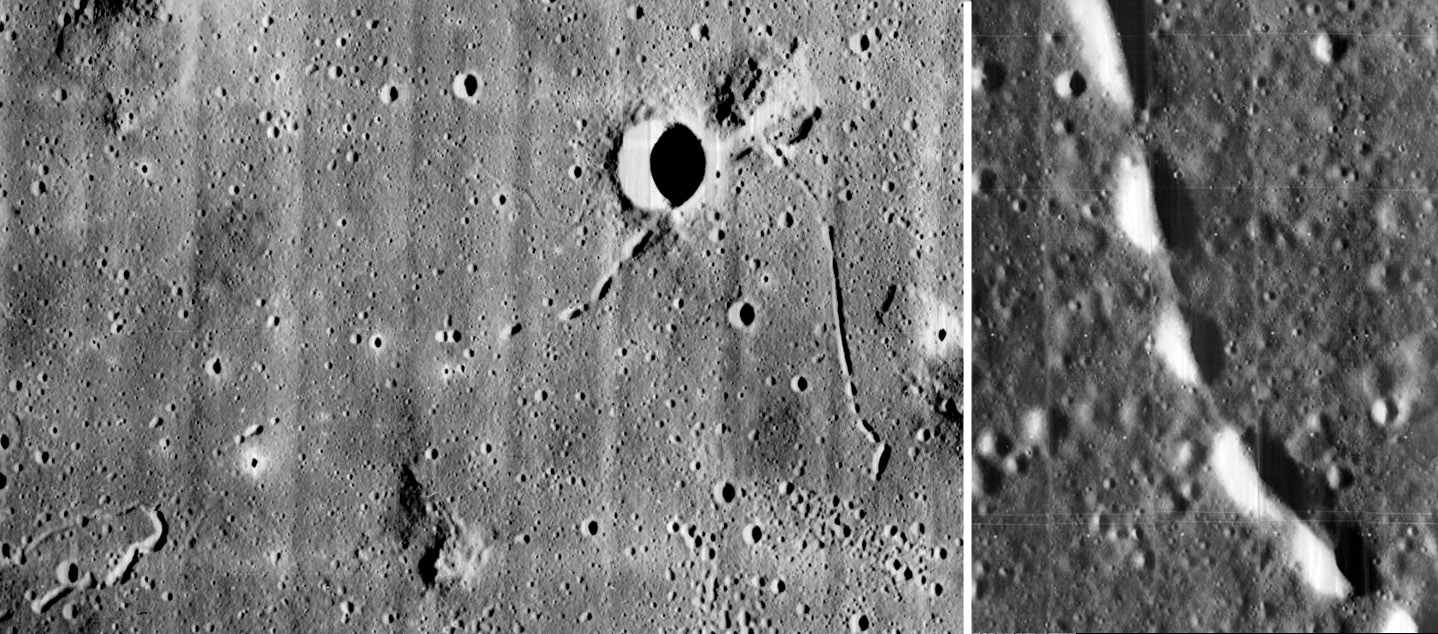January 1, 2019
Trail of Skylights
Originally published October 23, 2009

Lunar Orbiter V-M213 and H213 (right) images from LPI Lunar Orbiter Photo Gallery
The Planetary Society's indefatigable Emily Lakdawalla reports that a team of Kaguya scientists is publishing an article about a skylight
discovered in a rille in the Marius Hills. Skylight is the word that cavers use to describe collapses of a cave roof thus connecting the surface
to the underground tunnel. The Marius Hills rilles, like all of the Moon's sinuous rilles, are most likely volcanic channels and tubes, so
skylights are not unexpected; certainly they are common in terrestrial lava tubes. But the Marius Hills lavas are probably about 3-3.5 b.y.
old so most lava tubes have long since been de-roofed by small scale meteorite cratering. The Kaguya discovery of a 65 m skylight is
interesting because it is sharp-edged and may have formed much more recently than the rilles. There are a number of other skylight
type depressions nearby and associated with other rilles that probably also mark lava tubes. In 1972 Dale Cruikshank and I published
descriptions of Hawaiian lava tubes and skylights and likely lunar examples. The image above is from our paper depicting two rilles in the
Marius Hills near the crater which may be the ~3 km wide Galilaei M. Both rilles appear to start on the edge of a volcanic hill, with the largest
rille having a characteristic tadpole-like vent area. Beyond the crater M the large rille becomes a series of elongated pits extending about 10
km and then a lack of collapses suggests a preserved tunnel whose direction is indicated by a cluster of pits about 8 km further to the southwest.
The narrower rille starts with a series of aligned pits and then has completely collapsed until near its southern end. There - seen better in the
high res version of the same image on the right - the pits are elongated and taper but mostly do not touch. Although volcanological nomenclature
is often not well defined I would say that these pits, like those along the larger rille, are skylights. Because the mare between the pits is continuous
the underlying lava tube has not collapsed. The Marius Hills remain a fascinating area for high resolution imaging, but intact lava tubes are
probably widespread across the lunar maria and may be enterable along skylights and abrupt rille terminations.
Chuck Wood
Related Links
Rükl plate 29
Yesterday's LPOD: The Other Apollo
Tomorrow's LPOD: Das Mystery
COMMENTS?
Register, Log in, and join in the comments.



